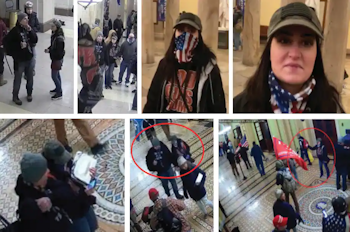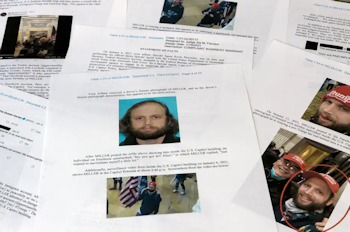2021 Storming of the
United States Capitol
The DOJ's U.S. Capital Mob Investigation
Jan 6, 2021


'One of the Largest Investigations in American History'
Number of Defendants Prosecuted & Volume of Evidence
How America’s surveillance networks helped the FBI catch the Capitol mob
Federal documents detailing the attacks at the U.S. Capitol show a mix of FBI
techniques, from license plate readers to facial recognition, that helped
identify rioters. Digital rights activists say the invasive technology can
infringe on our privacy.
One couple's case is among the more than 1,000 pages of arrest records, FBI
affidavits and search warrants reviewed by The Washington Post detailing one
of the biggest criminal investigations in American history. More than
320 suspects have been charged in the melee that shook the nation’s capital
and left five people dead.
The federal documents provide a rare view of the ways investigators exploit the
digital fingerprints nearly everyone leaves behind in an era of pervasive
surveillance and constant online connection. They illustrate the power law
enforcement now has to hunt down suspects by studying the contours of faces, the
movements of vehicles and even conversations with friends and spouses.
The cache of federal documents lays out a sprawling mix of FBI techniques:
license plate readers that captured suspects’ cars on the way to Washington;
cell-tower location records that chronicled their movements through the Capitol
complex; facial recognition searches that matched images to suspects’ driver’s
licenses or social media profiles; and a remarkably deep catalogue of video from
surveillance systems, live streams, news reports and cameras worn by the police
who swarmed the Capitol that day.
Agents in nearly all of the FBI’s 56 field offices have executed at least 900
search warrants in all 50 states and D.C., many of them for data held by the
telecommunications and technology giants whose services underpin most people’s
digital lives. The responses supplied potentially incriminating details about
the locations, online statements and identities of hundreds of suspects in an
investigation the Justice Department called in a
court motion last month “one of the largest in American history, both in
terms of the number of defendants prosecuted and the nature and volume of the
evidence.”
&uuid=(email))
The federal documents cite evidence gleaned from virtually every major social
media service. In at least 17 cases, the federal documents cite records from
telecommunications giants AT&T, Verizon or T-Mobile, typically after serving
search warrants for a range of subscriber data, including cellphone locations.
Investigators also sent “geofence” search warrants to Google. Federal officials
filed similarly broad search warrants to Facebook, demanding the account
information associated with every live stream that day from inside the vast
complex.
License plate readers and facial recognition software together played a
documented role in helping identify suspects in nearly a dozen cases, the
federal records show.
Some cases hinged on facial recognition tips submitted to the FBI by outside
agencies. After the FBI published “be on the lookout” bulletins with suspects’
photos police forces from around the country began submitting positive
responses from far away as California. With Miami sending in 13 possible
matches.
The FBI also has been aided by the online army of self-proclaimed “sedition
hunters,” like the one who helped identify Caldwell. They scoured the Web
for clues to track down rioters and often tweeted their findings publicly in
what amounted to a crowdsourced investigation of the Capitol attack. The
citizen sleuths organized their pursuits with hashtags: Tagging one rioter "#slickback"
because ofthe way he wore his hair.
The incidents described remain allegations, with none of the cited cases having
been adjudicated yet. In most cases, suspects’ attorneys have not yet filed
defenses against charges that in many instances are only a few weeks old, court
records show.
Many cases also hinge on imperfect technology and fallible digital evidence that
could undermine prosecutors’ claims. Blurry license plate reader images,
imprecise location tracking systems, misunderstood social media posts and
misidentified facial recognition matches all could muddy an investigation or
falsely implicate an innocent person.
washingtonpost.com